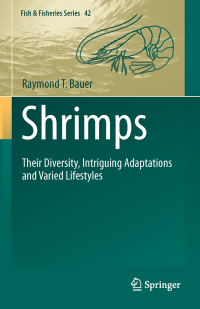Text
Shrimps: their diversity, intriguing adaptions and varied lifestyles
Shrimps are animals known to most people as nutritious and tasty food items. Shrimp fisheries and aquaculture are a vital part of US and world economies. These crustaceans are key ecological and food-web components of marine and freshwater habitats. Shrimps occur in all oceanic depths and latitudes. The 4400 species of decapod shrimps are amazingly diverse in size, shape, coloration, and natural history. Perhaps, it is no wonder that I have spent the last 52 years of my life in the study, research, publication, and teaching of marine science and crustacean biology, with a focus on shrimps. It became obvious to me that a book covering all the shrimps was needed and desired by marine biologists, zoologists, and carcinologists (crustacean biologists), as well as by applied scientists and amateur naturalists. Thus, in 2017, I launched into the writing of this book to cover those crustaceans recognized by most persons as “shrimps,” i.e., the groups belonging to the crustacean order Decapoda: Dendrobranchiata (penaeoids and sergestoids), Caridea, Procarididea, and Stenopodidea. In this book, I cover important aspects of the organismal biology and natural history of shrimps: taxonomy, ecological diversity, structure and function of shrimp anatomy, antifouling adaptations, coloration and camouflage, reproductive biology, sexual systems, mating systems and behavior, life-history strategies, shrimp symbioses (parasitism, commensalism, and mutualism), and the evolution of shrimps. The book is based on past and present scientific literature (journal publications and books) as well as my own research and experience. I point out remaining questions about shrimps which need investigation and propose hypotheses for testing them. This book is envisioned as a comprehensive reference and source of information, a “go-to” book about shrimps. I have tried to write in a style appealing to a wide audience: advanced undergraduate and postgraduate students, academic scientists, and fisheries and aquaculture professionals, as well as amateur naturalists, aquarists, and interested laypersons.
Ketersediaan
Informasi Detail
- Judul Seri
-
-
- No. Panggil
-
639.5 RAY s
- Penerbit
- Switzerland : Springer Nature Switzerland., 2023
- Deskripsi Fisik
-
-
- Bahasa
-
English
- ISBN/ISSN
-
9783031209666
- Klasifikasi
-
639.5
- Tipe Isi
-
-
- Tipe Media
-
-
- Tipe Pembawa
-
-
- Edisi
-
Ed. 1
- Subjek
- Info Detail Spesifik
-
-
- Pernyataan Tanggungjawab
-
Raymond T. Bauer
Versi lain/terkait
Tidak tersedia versi lain
Lampiran Berkas
Komentar
Anda harus masuk sebelum memberikan komentar

 Karya Umum
Karya Umum  Filsafat
Filsafat  Agama
Agama  Ilmu-ilmu Sosial
Ilmu-ilmu Sosial  Bahasa
Bahasa  Ilmu-ilmu Murni
Ilmu-ilmu Murni  Ilmu-ilmu Terapan
Ilmu-ilmu Terapan  Kesenian, Hiburan, dan Olahraga
Kesenian, Hiburan, dan Olahraga  Kesusastraan
Kesusastraan  Geografi dan Sejarah
Geografi dan Sejarah